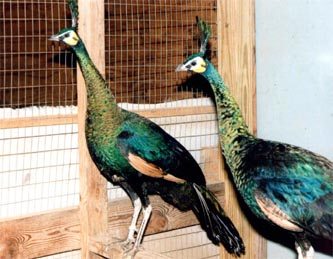I frequently get phone calls from people who ask me how to build housing for peafowl (pens). This is difficult to do because there is not one way that is right for everyone and what works in my area may not work in theirs. I try to relate the successes (and failures) I’ve had over the years and focus on not “how to” but on “how about”.
There are many things to consider when building your new pens and one of the most important is selecting the location. The site should be higher than the surrounding ground and provide good drainage. After deciding on your location consider how many pens you want and how large you want them (for comfort plan on at least 80 sq. ft. per bird), then ask yourself if the site is large enough for your project. If you are like most of us one pair of birds will not be the end and if you catch the ‘Peafowl Fever” you will find that you quickly run out of room. It seems that almost everyone I talk to is in some phase of building and no one ever seems to have enough pens or room for more.
Consider your seasonal climate and the winds in your area. I like to place the back of my pens facing the prevailing wind and then enclose that end to make a windbreak. Peafowl are fairly tolerant to all but the coldest weather and really require little by way of shelter in the southern states. If you live in the northern states, however, you will require much more protection for your flock and some northern breeders have completely enclosed and heated buildings to winter their flocks.
When selecting your building materials consider things like: climate, predator problems, size of your project, and your budget. When framing your pens think about post spacing and the load the frame will need to withstand (8-12 feet apart is average) and consider your roofing or cover material. In most areas a few sheets of tin over one end and some flight netting is enough but in areas with large accumulations of snow or high winds your framing (as well as your cover) will need to be heavier to support these conditions. Chicken wire is frequently used and works well in arid regions like the Midwestern states, however, it rusts very quickly in a humid environment. Flight netting is good for run divider walls and tops but is not recommended for exterior sides be-cause predators can easily chew through it. A good quality 2″ x 4″ welded wire or chain link makes a good exterior side material but can get expensive if you build tall pens (which should be 6-8 feet high). If you use either of these it is a good idea to have a small mesh (1 “x 2″ or smaller) on the bottom 2-3 feet of the outside to prevent your birds from sticking their necks through and getting hung or decapitated. If you build your pens side-by-side remember to put up a sight barrier or your males will spend all year worrying about what the male in the next run is doing (and trying to fight) instead of paying attention to his hens. Make the door to the run wide enough to get a wheelbarrow through which will help when cleaning and also when moving birds. Place several roosts about the run at different heights, these can be made from dead tree limbs or 2″ x 4” lumber, if you do use lumber do not use pressure treated for the roosts and turn them fiat to give the birds a good perch. Place some cover in the run so the hen can hide from the male, especially if the male is “overactive” or you want the hen to brood her eggs.
If you have a predator problem you can turn out about 12″ of mesh toward the outside or bury the wire to discourage predators from digging in or you can pour cement around the outside of you pens (2″ wide by 12″ deep will stop all but the most determined). You may also consider running an electric fence around the pens about 2″ out and 2-3″ up from the bottom and again 2-3″ from the top (this stops climbing predators). When covering your pens don’t stretch the material as tight as possible but leave a little slack in it. This slack provides for some seasonal stretching and contraction and also provides some “give” if your birds become upset and hit the top. If you consider these things I think you will be satisfied and your birds should be happy in their new home.
Submit your review | |

